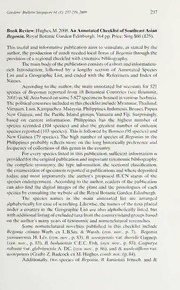
An Annotated Checklist of Southeast Asian Begonia by M. Hughes PDF
Preview An Annotated Checklist of Southeast Asian Begonia by M. Hughes
Gardens'Bulletin Singapore61 (J):237-239.2009 237 Book Review: Hughes,M.2008.AnAnnotated ChecklistofSoutheastAsian Begonia. Royal Botanic Garden Edinburgh. 164 pp. Price: Sing $60 (£25). This useful and informative publication aims to stimulate, as stated by the author, the production of much needed local floras of Begonia through the provision ofa regional checklist with extensive bibliography. Themainbodyofthe publicationconsistsofashortandinformation- rich Introduction, followed by a lengthy section of Annotated Species List and a Geographic List, and ended with the References and Index of Names. According to the author, the main annotated list accounts for 521 species of Begonias reported from 18 Botanical Countries (see Brummit, 2001) in SEAsia based on some 5,827 specimens housed in variousherbaria. The politicalcountries included in thischecklist include Myanmar,Thailand, Vietnam,Laos,Kampuchea,Malaysia,Philippines, Indonesia,Brunei,Papua New Guinea, and the Pacific Island groups, Vanuatu and Fiji. Surprisingly, based on current information, Philippines has the highest number of species recorded (104 species) and also the greatest number of endemic species reported (103 species). This is followed by Borneo (95 species) and New Guinea (79 species). The high number of species of Begonias in the Philippines probably reflects more on the long historically preference and frequency ofcollections ofthis genus in the country. For every species listed in this publication, sufficient information is provided forthe original publication and important taxonomic bibliography, the complete synonymy, the type information, the sectional classification, the enumeration ofspecimensreported in publications and where deposited today, and most importantly, the author's proposed IUCN status of the species endangerment. According to the author, readers of the publication can also find the digital images of the plant and the protologues of each species by consulting the website of the Royal Botanic Garden Edinburgh. The species names in the main annotated list are arranged alphabetically for ease ofsearching. Likewise, the names of the taxa placed under a country in the Geographic List are also alphabetically listed, but with additional listingofexcludedtaxafrom the country/islandgroupsbased on the author's many years oftaxonomic and nomenclatural researches. Some nomenclatural novelties published in this checklist include Begonia cristata Warb. ex L.B.Sm. & Wassh. {syn. now, p. 7), Begonia yunnanensis H. Lev. (syn. nov., p. 83), B. sootepensis var. thorelii Gagnep. (syn. nov., p. 83), B. lushaiensis C.E.C. Fish. (syn. nov., p. 83), Casparya robusta var. glabriuscula A. DC. (syn. now, p. 86), and B. modestiflora var. sootepensis (Craib) Z. Badcock ex M. Hughes, comb. nov. (p. 84). Additionally, two species of Begonia, B. kaniensis Irmsch. and B. 238 Card. Bull.Singapore6/ (I)2009 demissa Craib, are beautifully illustrated. What I find most elucidating and informative about this publication is the many comments of the author provided for many species throughout the publication as Notes to explain the confusing history ofa name,the past errorsmadeinreportingaspecies,the author'staxonomicinterpretation,the allegedandcorrectedrangeinformation,aswell asthejustificationofrevised sectional classification. All these notes showthe profound knowledge ofthe author for the genus, taxonomically, nomenclaturally and bibliographically. Having been involved in the study of the flora of the Philippine Archipelago for many years, I did find a few small errors in the spelling of locality and the collector names that deal with the Philippine taxa. For examples, the collector name of "Edano" has been written inaccurately as "Edano", and the town name, "Penablanca" in Cagayan Province is mis- spelled as "Panablanca". Moreso, the locality name of Mt. Makiling is the same as Mt. Maquiling, and Mt. Banahao is the same as Mt. Banajao. Mt. Susong-Dalaga (female breast) in Rizal Province (see p. 37) is mis-spelled as Mt. Susong-Dalanga. "Baranguay San Jose" on p. 26, the type locality under B. chloroneura P. Wilkie & Sands, should be written as "Barangay San Jose". The type locality of B. longibractea Merr. (see p. 72) is Siargao Island, and not Siargo Island as printed. Also, the type locality of Begonia subtruncata Merr. in Union Province (see p. 125) is today known as "La Union Province". Likewise,the type locality,"Banos" town,ofB. aequataA. Gray in Laguna Province (p. 4), is to be "Los Banos" town. I have two nomenclatural points to make. (1) The listing of the accepted name for the homotypic synonymy between Begonia wenzelii Merr. (1915) and B. leytensis Merr. (1914), in favour of the former (p. 138), is not clearly stated. The latter name is actually a junior homonym of B. leytensis Elm. (2) Naked names, like B. bulusanensis Elmer ex Merr. and B. hemicardia Elmer ex Merr. on p. 15,B. neopurpurea L.B.Sm. & Wassh. on p. 89, and B. sorsogonensis (Merr.) Elmer on p. 121, lack a type specimen, but have an original specimen. The workers and students of Begonia in SE Asia should be grateful to the author for compiling such a useful publication that builds the bibliographical groundwork for the documentation of the richness of the species of this genus in the region; many of them are local endemic and have high ornamental value. Seen in this light, this publication should be considered essential and a bible to plant growers,landscapers and gardeners who need to check on the correct name of a species of Begonia from SE Asia used in horticulture. Literature Cited: Brummit, R.K. 2001. World Geographical Scheme for RecordingPlant Distributions. Hunt Institute for Botanical Documentation, Rhododendronsojolense 239 Pittsburgh. B. C.Tan The Herbarium Singapore Botanic Gardens
